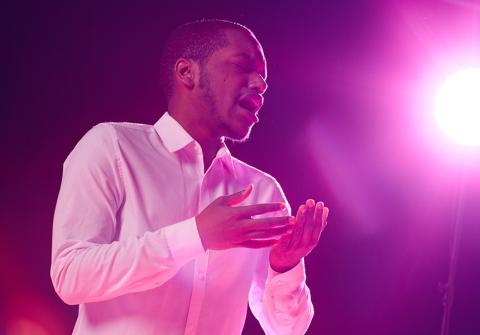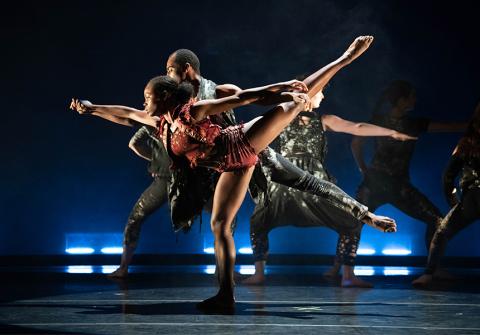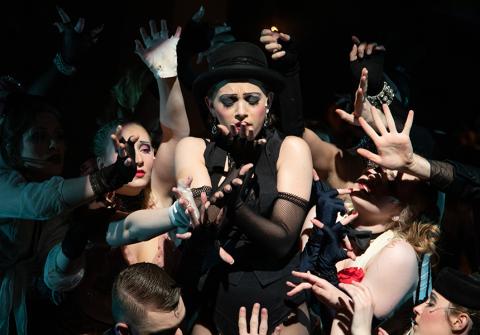A Singular Institution for a Plural World

Photo by Dave Green
The 2016 merger between The Boston Conservatory and Berklee College of Music marked the first time two performing arts colleges joined forces, setting off a powerful ripple effect of groundbreaking “firsts” across the Conservatory’s three divisions and the wider Berklee organization—not to mention higher education and the performing arts at large.
Three years into this historic move, we reflect on the joint institution’s pioneering collaborations, genre-combusting performances, and innovative learning opportunities through the lens of the question: What milestones could have only been possible in this unique space—the world’s most complete training ground for performing artists?
Making History Through Experimentation, Collaboration
The primary goal of the merger was—and remains—preparing students for 21st-century careers in the performing arts. That means providing a breadth of opportunity and the experimental space where original forms of expression are created, so that boundaries that have defined traditional conservatory education may be tested and transcended. To that end, the 2018–2019 academic year in particular was bursting with innovations at every turn, both in the classroom and on stage. From partnerships with mission-driven global organizations to residencies with legendary artists to touring opportunities with renowned ensembles, Boston Conservatory students had more opportunities than ever to engage with artists, genres, and cultural traditions outside of the typical conservatory curriculum—and make history in the process.

The Metallica Project, presented at Boston Conservatory's 2019 spring dance concert, Limitless. Photo by Jim Coleman
The Metallica Project
What better encapsulation of the cross-disciplinary experimentation happening on campus than a piece exploring the intersection of dance, heavy metal, Balkan and Indian musical styles, global jazz, and American bluegrass? At Boston Conservatory’s 2019 spring dance concert, Limitless, these strands came together in the Metallica Project, a contemporary dance reimagination of four Metallica songs arranged, recorded, and performed in different styles by Berklee College of Music ensembles—the Berklee Indian Ensemble, the Berklee Balkan Choir, the Berklee Global Jazz Ensemble, and the Berklee American Roots Ensemble—and choreographed by Otis Sallid.
“Collaborating with Otis Sallid and Boston Conservatory dancers was so exciting,” says Anastassiya Petrova, who performed in the Berklee Global Jazz Ensemble. “The music we study and create at the Berklee Global Jazz Institute encourages the use of space, imagination, and openness to experimentation, and the mixture of Metallica, jazz, and dance is an experiment we wouldn't have imagined before.”
Silkroad
Boston Conservatory’s increasingly global approach is also reflected in the Music Division’s new partnership with the international arts organization Silkroad. To kick off the collaboration, Boston Conservatory Orchestra shared the stage at Boston’s Symphony Hall on November 16, 2018 with tabla virtuoso Sandeep Das, Celtic harp innovator Maeve Gilchrist, and composer/musician Kaoru Watanabe for a unique program featuring musical traditions from around the world, earning them a standing ovation from an audience of more than 1,200.
WATCH: Boston Conservatory Orchestra and Sandeep Das Perform at Symphony Hall
“Being exposed to and—more importantly—performing with these world-class musicians in an entire concert of nonstandard orchestral literature was an extraordinary experience for the Conservatory’s orchestra students,” says Professor of Orchestral Studies Bruce Hangen, who conducted the concert. “It represented a concept from which all Conservatory students could learn and develop in their future careers.”
Boston Conservatory’s partnership with Silkroad also extends to the classroom, in the form of the Silkroad Creativity Lab. Launched in January 2019, this collaborative course provides an opportunity for Boston Conservatory at Berklee and Berklee College of Music students to explore the process of creating with people who are different from themselves, with a particular focus on artistic risk—and how risk strengthens artists’ sensibilities as both individual storytellers and contributors to a collective story. Because of this, the course is open to students in all divisions, and the inaugural class included dancers and theater artists in addition to Conservatory and College musicians.
Identity as the Artist's Foundation
Opportunities like the Silkroad Creativity Lab reflect how the Conservatory prioritizes giving students the self-reflexive space to examine the role of the artist in a multicultural world. With questions of identity becoming increasingly central to our larger cultural conversation, Boston Conservatory is intensifying its focus on the artist's individual voice, purpose, and style throughout the educational process. Here, students are encouraged to dig deep and take risks: self-discovery is viewed as the kindling that sparks original forms of expression and ignites the passion that sends artists out to be agents of positive change in the world.
“I believe helping students to define their identity is the greatest challenge we can give them,” says Associate Professor of Dance Kurt Douglas. “It sparks a curiosity about their place in the world and pushes them to ask questions about the meaning within the process.”
He adds that the Conservatory’s unique approach “allows each student to discover and define their voice by their own experiences as moving bodies in the world. This includes discussions about race, gender, class, and social structures, and it provides students with the tools to succeed in an ever-evolving field and the opportunity to discover what makes them uniquely vulnerable and human.”
African Voices in Contemporary Music
The work of Conservatory faculty, too, is infused with themes of self- discovery and identity, modeling endless new artistic possibilities for students. In fall 2018, Vimbayi Kaziboni, assistant professor of orchestral studies and contemporary music, conducted a program fully dedicated to contemporary African composers that featured Boston Conservatory Contemporary Classical Music Ensemble: contraBAND—the first performance of its kind at the Conservatory.
WATCH: Kevin Madison (P.S.C. '21, piano) Performs "Ukom," Presented at the Contemporary African Composers Concert
“A big part of what the composers are grappling with is identity—of being an African composer, an African artist within the realm of a European tradition,” explains Kaziboni. “Essentially, these composers are grappling with the issues that I grapple with in my daily life as a Zimbabwean conductor in classical music.”
Roselyn Hobbs (M.M. '19, contemporary classical music), who played viola in Hamza El Din’s “Esclay” as part of this performance, says she loved having the opportunity to perform the music of African composers for a Western audience. “There’s amazing music coming out of every corner of the world,” she says, “and I’m grateful for any experience that allows us to hear and play music beyond the bubble of the Western tradition.”

Bowie Symphonic: Blackstar, February 2019. Photo by Christine Southworth
Bowie Symphonic: Blackstar
Hobbs also performed on tour as part of another unusual Conservatory collaboration called Bowie Symphonic: Blackstar, in which Boston Conservatory students joined soloist Maya Beiser and the Ambient Orchestra, led by composer/conductor Evan Ziporyn, for performances of cultural icon David Bowie's complete final album, Blackstar. The tour included stops in California, Texas, Virginia, and Vermont, as well as a final sold-out performance at Boston’s Isabella Stewart Gardner Museum in February 2019.
“The Blackstar tour was an incredible experience,” says Hobbs. “Working with Evan Ziporyn, who is so passionate about Bowie’s music, and playing alongside the members of the Ambient Orchestra to perform music that reaches a larger audience than most contemporary music we play in the contemporary classical music program was pretty powerful, both for me and for audience members.”
Diversity and Inclusion On Stage and in the Classroom
As the Blackstar project suggests, Boston Conservatory honors the past while also acknowledging that performing arts education must reflect the present and imagine the future. This often means reimagining classics so that they’re relevant to today’s world and reflective of our values of diversity and inclusion.

Boston Conservatory's March 2019 production of Cabaret. Photo by Max Wagenblass.
Cabaret
A case in point was Boston Conservatory’s March 2019 production of Cabaret, directed by legendary artist Otis Sallid. His fresh spin on Kander and Ebb’s musical theater masterpiece emphasized the Afro-German struggle during the rise of the Nazi Party in Germany by casting an African American in the role of the Emcee— which is rarely, if ever, done. To fill out the character’s backstory, Sallid and the actor portraying the Emcee, Aaron Patterson (B.F.A. '21, musical theater), also opted to make him an immigrant from Cameroon, introducing another distinctive element to Sallid’s interpretation.
“Our society is diverse, so it’s especially important to us to diversify our shows and the people involved in them,” says Patsy Collins Bandes, interim chair of theater at the Conservatory. “We thought this show would apply to the current political moment and its discourse about people who live their lives by different sets of rules.”
Reframing Gender Constructs
Boston Conservatory’s efforts to foster its values of diversity and inclusion in the classroom have not gone unnoticed. In December 2018, Dance Magazine highlighted the Conservatory’s bold move of renaming three courses—Men's Class, Women's Variations, and Pas de Deux—to include the qualifier “Constructed Gender Identities in Classical Ballet.”
The decision was meant as a statement of the school’s commitment to inclusivity in the classroom, signaling to students that they are welcome to take any ballet course that interests them, regardless of their gender identity. It marked the first time that a conservatory dance program implemented such a fundamental change in its approach to dance training.
This change was also designed to engage dancers in thinking critically about how they interpret and approach ballet within a specific historical context. “Classical ballet is built around a particular presentation of gender that reflects a specific moment in time,” Conservatory Senior Vice President and Executive Director Cathy Young explains. “This is not at all about dismantling ballet traditions, or devaluing traditions. It's about reframing how we present this material to our students, so that everyone can engage with this form.”
Creating Welcoming Artistic Spaces
The Theater Division is also working to establish welcoming classrooms and safe artistic spaces, with particular attention to incorporating best practices in theatrical intimacy. In April 2019, the Theater Division joined with StageSource to offer workshops led by Claire Warden of Intimacy Directors International that focused on creating respectful and consent-based artistic spaces. The Conservatory hosted four workshops on campus: two for performing artists, one for administrators, and one for faculty.
These milestones speak directly to what makes Boston Conservatory such a singular institution: one that aims to reshape the traditional conservatory model into a more dynamic, collective, multidimensional space that is continually informed, formed, and transformed by individual perspectives.
"A Singular Institution for a Plural World" first appeared in the summer 2019 issue of STAGES, Boston Conservatory's biannual magazine.
